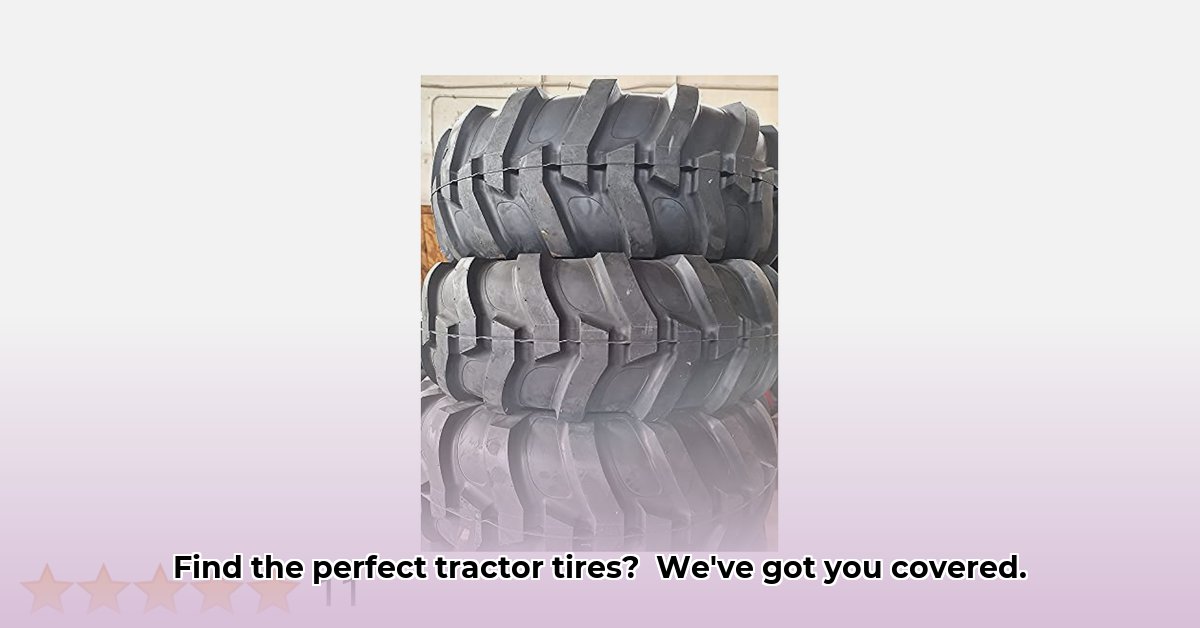
Choosing the right tires for your tractor, backhoe, or loader is critical for performance and safety. This buyer's guide focuses specifically on 17.5 x 24 tires, helping you navigate the selection process and find the perfect fit for your needs and budget. We'll dissect key features, compare available options, and offer practical advice to make your purchase decision easier. For information on other tire sizes, check out our guide on 7.50-16 tractor tires.
Understanding 17.5 x 24 Tractor Tires
The 17.5 x 24 designation refers to the tire's dimensions: 17.5 inches wide and 24 inches in diameter. These tires are commonly used on agricultural and construction equipment, designed for heavy loads and varied terrain. However, a crucial distinction exists: many tires advertised as 17.5 x 24 are actually 17.5L x 24, indicating a low-profile design with a shorter sidewall. This subtle difference significantly impacts your equipment’s ride and handling.
Key Features and Considerations
Several factors influence tire performance and longevity. Let's examine the most crucial:
Load Capacity: This is paramount. Ensure the tire's load capacity rating comfortably exceeds the combined weight of your machine and its typical load. Underestimating this can lead to tire failure and potential accidents. Think of it like choosing a bridge that can safely support the expected traffic. Overloading tires significantly shortens their lifespan.
Tread Pattern: The tread pattern dictates traction, significantly impacting performance on different surfaces. The common R-4 pattern offers good versatility, suitable for a mix of paved and unpaved surfaces. The R-1 pattern is better suited for mainly hard surfaces. Selecting the right pattern depends on your predominant operating environment. Consider factors like mud, gravel, and paved roads.
Tubeless vs. Tube-Type: Tubeless tires offer superior sealing, reducing the risk of punctures. Tube-type tires, while often cheaper upfront, are more prone to flats and require more maintenance.
Ply Rating (PR): The PR indicates the tire's sidewall strength. Higher PR numbers (e.g., 12, 14) denote stronger sidewalls, better resisting punctures and damage from impacts. Consider your terrain and the potential for impacts when selecting your PR rating.
Data Limitations: Comprehensive, standardized testing data for 17.5 x 24 tires is unfortunately limited. This makes direct comparisons between brands and models challenging. We will address this issue transparently throughout this guide.
Tire Comparison Table: A Realistic Approach
Direct comparison across brands and models is difficult due to inconsistent data across manufacturers. The lack of universally accepted testing standards prevents definitive "better" or "worse" labeling. The following table provides a general comparison based on available information – always refer to the manufacturer’s specifications for precise details.
| Brand | Model | Load Capacity (lbs) (approx.) | Ply Rating | Tread Pattern | Tubeless/Tube-Type | Pros | Cons |
|---|---|---|---|---|---|---|---|
| Brand A | Model X | 7000 | 12 | R-4 | Tubeless | High load capacity, durable sidewalls | Higher price point |
| Brand B | Model Y | 6500 | 10 | R-4 | Tube-Type | More affordable, readily available | Potentially shorter lifespan, higher risk of flats |
| Brand C | Model Z | 6800 | 12 | R-1 | Tubeless | Excellent traction on hard surfaces | Weaker sidewalls compared to Brand A (potential) |
*Approximate values; consult manufacturer specifications for accurate details.
Buying Advice: Tailoring Your Choice
The optimal tire depends heavily on your specific needs and operating conditions:
Terrain: Rough terrains mandate higher ply ratings and aggressive tread patterns for enhanced grip and durability. Smoother terrains allow for less-aggressive patterns.
Workload: Estimate the maximum load your tractor will consistently carry. Select tires with a load capacity substantially exceeding this value for a safety margin.
Budget: Tire prices vary considerably. Balance desired performance with your financial limitations. Consider the total cost of ownership, including replacement costs.
Where to Buy
Reputable agricultural equipment suppliers, farm supply stores, and online retailers (with customer reviews) are your best bets for purchasing 17.5 x 24 tractor tires. Always compare prices and shipping costs from multiple vendors.
Maintenance and Safety
Regular maintenance is crucial for both tire longevity and safety.
Pressure Checks: Regularly check tire pressure using an accurate gauge, and maintain the manufacturer's recommended inflation. Underinflation increases wear, while overinflation can damage the tire.
Visual Inspections: Inspect tires for cuts, punctures, or unusual wear patterns. Address any issues immediately.
Rotation: Rotate tires periodically for even wear and extended lifespan.
Conclusion: Informed Decisions for Optimal Performance
Selecting the correct tires is crucial for safety, efficiency, and the lifespan of your equipment. This guide provides a solid foundation for making an informed buying decision. However, remember to consult with an agricultural equipment specialist for personalized advice tailored to your specific needs and operating environment. Always prioritize safety and adhere to manufacturer guidelines for optimal performance and longevity.